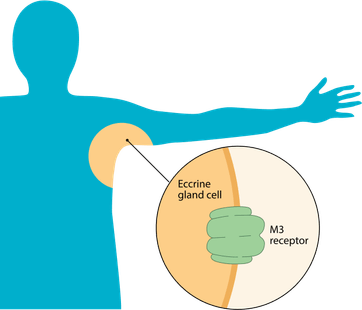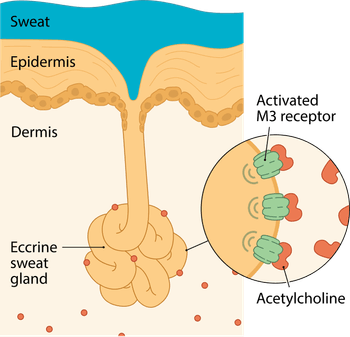Novel Sofdra MOA
Sofdra is a novel
topical agent created to block M3 receptors in sweat glands1,2


—commercially insured patients pay $0*
M3 is the receptor primarily involved in eccrine sweat gland signaling3,4

Dysregulated muscarinic signaling in an untreated eccrine sweat gland

Targeted M3 inhibition in a sweat gland treated with Sofdra


Indication
Sofdra™ (sofpironium) topical gel, 12.45% is an anticholinergic indicated for the treatment of primary axillary hyperhidrosis in adults and pediatric patients 9 years of age and older.
IMPORTANT SAFETY INFORMATION
Contraindications
Sofdra is contraindicated in patients with medical conditions that can be exacerbated by the anticholinergic effect of Sofdra (e.g., glaucoma, paralytic ileus, unstable cardiovascular status in acute hemorrhage, severe ulcerative colitis, toxic megacolon complicating ulcerative colitis, myasthenia gravis, Sjögren’s syndrome).
Warnings & Precautions
Urinary retention
Use Sofdra with caution in patients with a history or presence of documented urinary retention. Patients should discontinue use immediately and consult a healthcare provider should any signs or symptoms of urinary retention develop (e.g., difficulty passing urine, distended bladder).
Control of Body Temperature
In the presence of high ambient temperature, heat illness (hyperpyrexia and heat stroke due to decreased sweating) can occur with the use of anticholinergic drugs, including Sofdra. Patients should avoid using Sofdra if not sweating when in hot or very warm environmental temperatures.
Operating Machinery or an Automobile
Transient blurred vision may occur with Sofdra. If blurred vision occurs, discontinue use and avoid engaging in activities that require clear vision (e.g., operating a motor vehicle or machinery, performing hazardous work) until the symptoms have resolved.
Adverse Reactions
The most common adverse reactions (≥2%) are dry mouth, vision blurred, mydriasis, and urinary retention. The most common local skin reactions (≥2%) are pain, erythema, dermatitis, pruritus, irritation, and exfoliation.
Drug Interactions
Avoid coadministration of Sofdra with other anticholinergic medications (due to risk of increase in anticholinergic adverse effects) and drugs that are strong inhibitors of CYP2D6.
Please see full Prescribing Information.